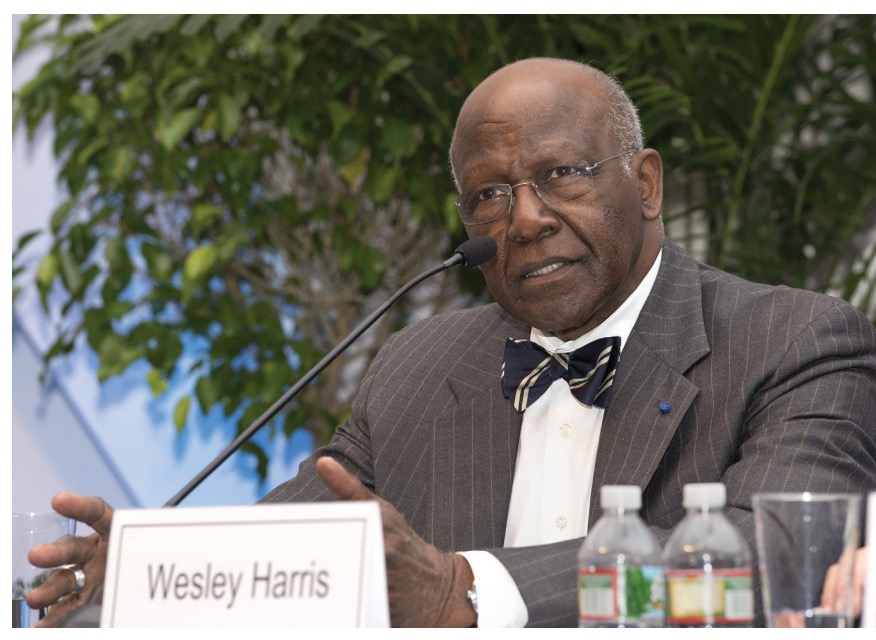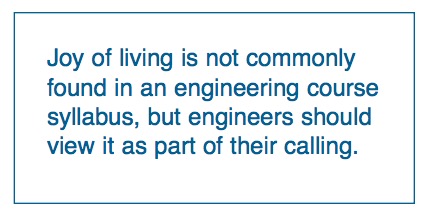NATIONAL ACADEMY OF ENGINEERING
I. Grand Challenges Revisited
For the forum at the National Academy of Engineering’s 2015 annual meeting, 7 of the 18 committee members who formulated the Grand Challenges for Engineering in 2008 reflected on what has happened in the seven years since. A common theme was surprise at how quickly and powerfully the idea has been embraced. “I personally had no idea, when I was part of this program, of the leverage it would have,” said Robert Socolow. Added Wesley Harris, “This has been an experience that, for me, has had spiritual content.”
This chapter presents an overview of the speakers’ remarks, and the second summarizes the wide-ranging exchanges afterward between the presenters and forum attendees.
The Need for Global Collaboration
 In the national shock that followed the Soviet Union’s October 1957 launch of Sputnik, the old National Advisory Commission for Aeronautics, a modest organization, was expanded into the National Aeronautics and Space Administration, a major federal agency. Then came President John F. Kennedy’s vow in 1961 that “This nation should commit itself to achieving the goal, before the decade is out, of landing a man on the moon and returning him safely to the earth.” Not that humanity would undertake this quest—that the United States would.
In the national shock that followed the Soviet Union’s October 1957 launch of Sputnik, the old National Advisory Commission for Aeronautics, a modest organization, was expanded into the National Aeronautics and Space Administration, a major federal agency. Then came President John F. Kennedy’s vow in 1961 that “This nation should commit itself to achieving the goal, before the decade is out, of landing a man on the moon and returning him safely to the earth.” Not that humanity would undertake this quest—that the United States would.
US decision making post-Sputnik was driven by “political, military, technological, and even scientific competition,” said Wesley Harris in his presentation. The Grand Challenges initiative must be different, he said. “It’s global in intent and global in its benefit. It is blind to economic, social, cultural, and religious differences. It thrives on a win-win outcome at all levels. It requires, it demands, it rewards cooperation and collaboration.”
He envisioned the Grand Challenges as the branches of a “mighty tree with a great crown that provides shade and protection for all of humanity.” But the tree also has roots “related to the things that drive us: education, government, research, and, equally important, collaboration around the globe.” The Grand Challenges are “about humanity and our service to humanity within our profession.”
Harris proposed that engineers institutionalize the Grand Challenges in the US National Academy of Engineering while seeking support from the world’s governments and recognition of the project from the United Nations. Each section of NAE members could assess and apply the Grand Challenges in their area and report back to the NAE council, he suggested. More broadly, engineers could call attention to the ways in which the Grand Challenges bear on food delivery, transportation networks, communications, and the other essential elements of modern life.
He also pointed out that, with another billion people expected to join the human family in Africa by 2050, that continent offers intellectual resources that “we cannot afford to ignore, and that we can capture through these Grand Challenges.”
New Environmental Awareness
 Robert Socolow observed that the 14 Grand Challenges fall into four categories. The first is sustainability—maintaining air and water quality, protecting freshwater quantity, preventing sea level rise, keeping forests and other ecosystems in good condition, and minimizing artificially triggered climate change. Next is personal and community health, because, he pointed out, “as individuals we can live fulfilling lives only if we are healthy.” But, he added, “people have a record of being dangerous to each other,” hence the third category, vulnerability and security.
Robert Socolow observed that the 14 Grand Challenges fall into four categories. The first is sustainability—maintaining air and water quality, protecting freshwater quantity, preventing sea level rise, keeping forests and other ecosystems in good condition, and minimizing artificially triggered climate change. Next is personal and community health, because, he pointed out, “as individuals we can live fulfilling lives only if we are healthy.” But, he added, “people have a record of being dangerous to each other,” hence the third category, vulnerability and security.
The fourth category, joy of living, does not sound like a traditional engineering concern, Socolow admitted, but “electronics deliver us music with marvelous fidelity. Air travel brings us access to the extraordinary variety of human cultures and natural settings. Electronics nurtures our curiosity by providing incredible access to information. Engineering in many forms enables many discoveries about our universe and the history of life, which we then share.” Joy of living is not commonly found in an engineering course syllabus, Socolow said, but engineers should view it as part of their calling.
He then spoke about his specialty, environmental soundness. “Human beings are modifying the global carbon cycle by burning fossil fuels at a rate that leads to the atmospheric concentration increasing by half a percent a year, with consequences that are not well understood. Nitrogen fertilizer production has more than doubled the rate at which the triple bond of the N2 molecule is broken. For eons, nitrogen fixation had been occurring at a rate of about 100 million tons per year. Now it’s over 200 million. Will that matter?”
Socolow proposed a test for today’s generation of engineering students. “They will confront a new concept, unburnable fossil fuels. These are fossil fuels the next generation should decide to leave underground and not burn, in order to limit the amount of climate change. This will entail very difficult questions. In which decades will the use of fossil fuels begin to be substantially curtailed? Will the poorest countries receive coal and oil preferentially for their development? Natural gas provides almost twice as much energy for the same amount of carbon emission, because more hydrogen comes out of the ground with each carbon atom compared to coal. So should natural gas be produced preferentially?” There is no consensus on the answers to these questions, but he predicted that “they are going to be front and center.”
Greater emphasis on environmental issues calls for a change in engineering education, Socolow suggested. “A significant fraction of engineering students need to learn about Earth, Earth system science, the atmosphere, the oceans, forests, ice,…” He pointed out that these subjects are typically considered environmental studies—“no one in the engineering cohort today is taking these courses, and professors are not advising engineering students to take them. So that is an action item…. Engineering cannot exist in a vacuum any longer.”
He also called for engineering professors to emphasize to their students that their profession must help the poorest. One billion people still depend on traditional biomass, which is harvested unsustainably. “Bundles of twigs for fuel are carried on people’s backs long distances,” Socolow said. “Cooking in tents and mud houses with unvented stoves is the number one killer associated with global energy use, due to respiratory disease.”
He recalled that when he was a junior faculty member at Yale the university’s president, Kingman Brewster, made the distinction between puzzle solving and problem solving. “Many of us trained as scientists and engineers basically do puzzle solving, which means there is a well-defined answer and you know it when you get it.” Problem solving, he said, is more complex: it is multidisciplinary, has fuzzy edges, and has no single clearly defined solution. The sustainability of the Earth’s ecosystem, for example, requires problem solving. It has many aspects, of which climate change is just one, and will require “ambition, multidisciplinarity, and humility” to solve.
Download full version (login required): Grand Challenges for Engineering
About the National Academy of Engineering
www.nae.edu
Founded in 1964, the National Academy of Engineering (NAE) is a private, independent, nonprofit institution that provides engineering leadership in service to the nation. The mission of the National Academy of Engineering is to advance the well-being of the nation by promoting a vibrant engineering profession and by marshalling the expertise and insights of eminent engineers to provide independent advice to the federal government on matters involving engineering and technology.
Tags: Engineering, Forum, National Academies, National Academy of Engineering






 RSS Feed
RSS Feed